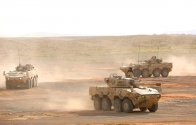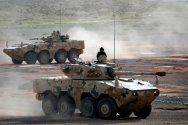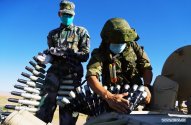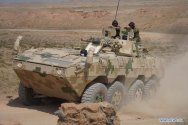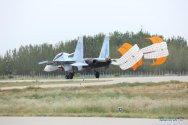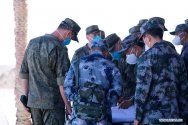You are using an out of date browser. It may not display this or other websites correctly.
You should upgrade or use an alternative browser.
You should upgrade or use an alternative browser.
Russian Military News, Reports, Data, etc.
- Thread starter tphuang
- Start date
From what I've seen, they don't really use the designation Destroyer, in general. The last time its use was widespread seemed to be in the 1950's. The only recent exception being the Sovremenny's.
Everything else, that was classified as a Destroyer in the west, usually got called something bland like "Large Anti-Submarine Ship" by the soviets.
Jumping in to provide some context:
The term "destroyer" is an abbreviation of "torpedo boat destroyer".
Torpedo boat destroyers were lightly armoured ships armed with small calibre guns (3-4 inch) meant for screening capital ships against torpedo boats - including submarines. With time torpedo boats grew in size to gain seaworthiness and torpedo boat destroyers were armed with torpedoes for torpedo attacks against capital ships. That's when "torpedo boat destroyer" was shortened to "destroyer" and began to perform a similar role that fighters do in air combat compared to bombers.
In Russian this is even reflected in the name: torpedo boat destroyers is: "истребитель миноносцев" ("istryebityel minonostsev" literally "torpedo boat hunter". The term "истребител" is also used for fighter aircraft performing air superiority roles (but not interceptors which are called "перехватчик" - pyerekhvatchik")
The key feature of destroyers at the time was the lack of secondary gun batteries - while destroyers have a single main battery the light cruisers have a main battery of long-barrelled 6-inch guns and a battery of short-barelled 4 or 5-inch guns for defense against small ships and boats. Torpedoes were not required because the primary function of the destroyer in main navies at the time was that of an escort ship.
The exception was Russia which due to numerical disadvantage against its opponents used destroyers as heavy torpedo boats. This is reflected in the change of name to "эскадренный миноносец" ("eskadryenniy minonosets", literally: squadron torpedo-carrier).
By the way - in Russian there's an abbreviation "эсминцев" (esmintsev) for the unwieldy "эскадренный миноносец". It works like this: эскадренный and миноносец and цев which is Russian way of making a personal noun out of things (mill - miller, farm - farmer). This abbreviation "эсминцев" not only doesn't mean anything (as abbreviations tend to do) but is not even proper abbreviation like Comintern (Communist International) for example. It really seems like a joke that a soldier would make when forced to use bad nomenclature that got accepted by the higher-ups because even the higher ups didn't like the original name.
Anyway, that designation (esmintsev) was used for post-WW2 destroyers until in the late 50s the main offensive capability was shifted to submarines and missile boats and large ships began to be used primarily for anti-submarine role.
The shift in doctrine is the reason why 1950s' Kotlin-class is a "эскадренный миноносец" (destroyer) but 1960s' Kashin-class is a "bольшой противолодочный корабль" ("bolshoy protyvolodotchniy korabl", literally: large anti-submarine ship).
Sovremenny-class is a "destroyer" because its primary armament was the 4,5 ton supersonic long-range P-270 Moskit (GRAU: 3M80) AShM and because it was designed with greater anti-air abilities (Buk) as well as with command facilities. It can serve as a capital ship for small task forces - which is why one ship still serves in the Baltic Fleet for example. It is not the weapons or radars but the ability to house a naval staff. Sovremenny fulfills the same role that was earlier intended for Kresta I (Berkut A) cruisers - classified as "крейсер", literally: "cruisers" - of which only four were built in the 60s. The reason why Sovremenny was not classified as a cruiser was the introduction of Slava and Kirov classes - first Slava was laid down at the same time as the first Sovremenny.
The reason why Gorshkov is called a "frigate" has nothing to do with Russian nomenclature but with how similar ships are designated in NATO navies. It helps with promoting the ships for export as well as allows for some flexibility in propaganda since Russia won't have to deal with having "destroyers which are weaker than western frigates". Russian navy doesn't use the designation of "frigate" but "сторожевой корабль" ("storozhevoy koryabl", literally: "guarding ship") and this designation is applied to both "frigates" such as Admiral Grigorovich or Admiral Gorshkov as well as "corvettes" as Stereguschiy or Gremashchiy.
Liders are "destroyers" because at this point these ships are a propaganda exercise. They are larger and better armed than Slava cruisers and are scaled-down version of Kirovs but because Kirovs are the navy's pride and were meant to serve until Lider's introduction Russians named their smaller Kirovs "destroyers" so it wouldn't seem like they're shrinking anything.
It's just fluff for the loud and obnoxious idiots who seem to constitute 90% of all public discourse and who always know everything about everything and feel qualified to pass summary judgments without appeal. Just note the reaction to the Su-75 a.k.a Checkmate and attempts to discredit it as a 5th generation fighter. Or the same attempts directed at Su-57 or J-20. It's loud, it's obnoxious and it's idiotic. And nothing else.
Hope this helps.
Last edited:
Thank you for the comprehensive explanation. It makes sense since the idea is was purely political didn't jive with the (little) information I had on russian designationsJumping in to provide some context:
The term "destroyer" is an abbreviation of "torpedo boat destroyer".
Torpedo boat destroyers were lightly armoured ships armed with small calibre guns (3-4 inch) meant for screening capital ships against torpedo boats - including submarines. With time torpedo boats grew in size to gain seaworthiness and torpedo boat destroyers were armed with torpedoes for torpedo attacks against capital ships. That's when "torpedo boat destroyer" was shortened to "destroyer" and began to perform a similar role that fighters do in air combat compared to bombers.
In Russian this is even reflected in the name: torpedo boat destroyers is: "истребитель миноносцев" ("istryebityel minonostsev" literally "torpedo boat hunter". The term "истребител" is also used for fighter aircraft performing air superiority roles (but not interceptors which are called "перехватчик" - pyerekhvatchik")
The key feature of destroyers at the time was the lack of secondary gun batteries - while destroyers have a single main battery the light cruisers have a main battery of long-barrelled 6-inch guns and a battery of short-barelled 4 or 5-inch guns for defense against small ships and boats. Torpedoes were not required because the primary function of the destroyer in main navies at the time was that of an escort ship.
The exception was Russia which due to numerical disadvantage against its opponents used destroyers as heavy torpedo boats. This is reflected in the change of name to "эскадренный миноносец" ("eskadryenniy minonosets", literally: squadron torpedo-carrier).
By the way - in Russian there's an abbreviation "эсминцев" (esmintsev) for the unwieldy "эскадренный миноносец". It works like this: эскадренный and миноносец and цев which is Russian way of making a personal noun out of things (mill - miller, farm - farmer). This abbreviation "эсминцев" not only doesn't mean anything (as abbreviations tend to do) but is not even proper abbreviation like Comintern (Communist International) for example. It really seems like a joke that a soldier would make when forced to use bad nomenclature that got accepted by the higher-ups because even the higher ups didn't like the original name.
Anyway, that designation (esmintsev) was used for post-WW2 destroyers until in the late 50s the main offensive capability was shifted to submarines and missile boats and large ships began to be used primarily for anti-submarine role.
The shift in doctrine is the reason why 1950s' Kotlin-class is a "эскадренный миноносец" (destroyer) but 1960s' Kashin-class is a "bольшой противолодочный корабль" ("bolshoy protyvolodotchniy korabl", literally: large anti-submarine ship).
Sovremenny-class is a "destroyer" because its primary armament was the 4,5 ton supersonic long-range P-270 Moskit (GRAU: 3M80) AShM and because it was designed with greater anti-air abilities (Buk) as well as with command facilities. It can serve as a capital ship for small task forces - which is why one ship still serves in the Baltic Fleet for example. It is not the weapons or radars but the ability to house a naval staff. Sovremenny fulfills the same role that was earlier intended for Kresta I (Berkut A) cruisers - classified as "крейсер", literally: "cruisers" - of which only four were built in the 60s. The reason why Sovremenny was not classified as a cruiser was the introduction of Slava and Kirov classes - first Slava was laid down at the same time as the first Sovremenny.
The reason why Gorshkov is called a "frigate" has nothing to do with Russian nomenclature but with how similar ships are designated in NATO navies. It helps with promoting the ships for export as well as allows for some flexibility in propaganda since Russia won't have to deal with having "destroyers which are weaker than western frigates". Russian navy doesn't use the designation of "frigate" but "сторожевой корабль" ("storozhevoy koryabl", literally: "guarding ship") and this designation is applied to both "frigates" such as Admiral Grigorovich or Admiral Gorshkov as well as "corvettes" as Stereguschiy or Gremashchiy.
Liders are "destroyers" because at this point these ships are a propaganda exercise. They are larger and better armed than Slava cruisers and are scaled-down version of Kirovs but because Kirovs are the navy's pride and were meant to serve until Lider's introduction Russians named their smaller Kirovs "destroyers" so it wouldn't seem like they're shrinking anything.
It's just fluff for the loud and obnoxious idiots who seem to constitute 90% of all public discourse and who always know everything about everything and feel qualified to pass summary judgments without appeal. Just note the reaction to the Su-75 a.k.a Checkmate and attempts to discredit it as a 5th generation fighter. Or the same attempts directed at Su-57 or J-20. It's loud, it's obnoxious and it's idiotic. And nothing else.
Hope this helps.
The SU-57 is reportedly going to receive a twin-seater version for command and control over S-70 “Okhotnik” UCAVs.
Speaking of which:
Looks much the same as the first in some respects (inlet, air data booms), though it might have fewer excrescences (no apertures visible for mounting most that were present on the previous airframe). It also *seems* as though the nozzle could be the integrated rather than axisymmetric type, as the outer mold line is smooth, without a bulge for the (non-functional) reheat plenum.
Looks much the same as the first in some respects (inlet, air data booms), though it might have fewer excrescences (no apertures visible for mounting most that were present on the previous airframe). It also *seems* as though the nozzle could be the integrated rather than axisymmetric type, as the outer mold line is smooth, without a bulge for the (non-functional) reheat plenum.
The Pantsir and Tigr system were also developed before any procurement.Having domestic customer buy-in is critical for export sales. I'm astonished that they announced this without even a token domestic commitment, and the fact that they did suggests the Russian Air Force is decidedly unenthusiastic about it.
This VRT lightweight choppers and UAVs are also without any domestic commitment. engines are now being developed.
now degree of confidence much higher but for some sanction reasons things are not announced.
infact showing this base to foreign correspondent is advertizing for further investment.

